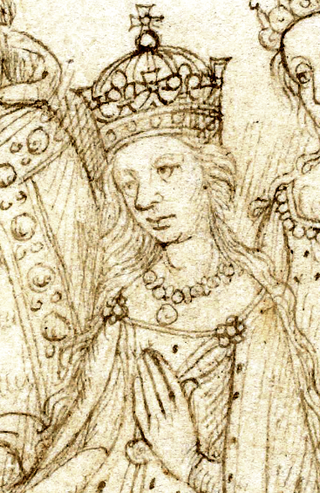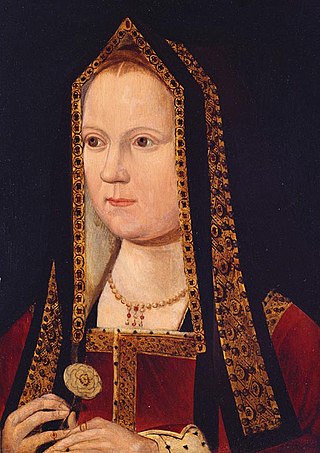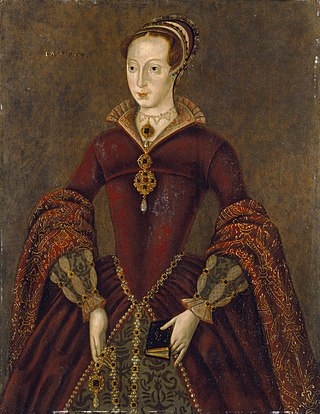
Catherine of Aragon was Queen of England as the first wife of King Henry VIII from their marriage on 11 June 1509 until their annulment on 23 May 1533. Born in Spain, she was Princess of Wales while married to Henry's elder brother, Arthur, Prince of Wales, for a short period before his death.

Henry VII was King of England from his seizure of the crown on 22 August 1485 until his death in 1509. He was the first monarch of the House of Tudor.

Lorenzo di Piero de' Medici (Italian: [loˈrɛntso de ˈmɛːditʃi], known as Lorenzo the Magnificent 1 January 1449 – 8 April 1492 was an Italian statesman, banker, de facto ruler of the Florentine Republic, and the most powerful and enthusiastic patron of Renaissance culture in Italy. He was a magnate, diplomat, politician and patron of scholars, artists, and poets. As a patron, he is best known for his sponsorship of artists such as Botticelli and Michelangelo. He held the balance of power within the Italic League, an alliance of states that stabilized political conditions on the Italian peninsula for decades, and his life coincided with the mature phase of the Italian Renaissance and the Golden Age of Florence. On the foreign policy front, Lorenzo manifested a clear plan to stem the territorial ambitions of Pope Sixtus IV, in the name of the balance of the Italian League of 1454. For these reasons, Lorenzo was the subject of the Pazzi conspiracy, in which his brother Giuliano was assassinated. The Peace of Lodi of 1454 that he supported among the various Italian states collapsed with his death. He is buried in the Medici Chapel in Florence.

Lucrezia Borgia was an Italian noblewoman of the House of Borgia who was the daughter of Pope Alexander VI and Vannozza dei Cattanei. She reigned as the Governor of Spoleto, a position usually held by cardinals, in her own right.

Pope Alexander VI, born Rodrigo de Borja, was head of the Catholic Church and ruler of the Papal States from 11 August 1492 until his death in 1503. Born into the prominent Borgia family in Xàtiva under the Crown of Aragon, Rodrigo studied law at the University of Bologna. He was ordained deacon and made a cardinal in 1456 after the election of his uncle as Pope Callixtus III, and a year later he became vice-chancellor of the Catholic Church. He proceeded to serve in the Curia under the next four popes, acquiring significant influence and wealth in the process. In 1492, Rodrigo was elected pope, taking the name Alexander VI.

The House of Tudor was a royal house of largely Welsh and English origin that held the English throne from 1485 to 1603. They descended from the Tudors of Penmynydd and Catherine of France. Tudor monarchs ruled the Kingdom of England and its realms, including their ancestral Wales and the Lordship of Ireland for 118 years with five monarchs: Henry VII, Henry VIII, Edward VI, Mary I and Elizabeth I. The Tudors succeeded the House of Plantagenet as rulers of the Kingdom of England, and were succeeded by the House of Stuart. The first Tudor monarch, Henry VII of England, descended through his mother from a legitimised branch of the English royal House of Lancaster, a cadet house of the Plantagenets. The Tudor family rose to power and started the Tudor period in the wake of the Wars of the Roses (1455–1487), which left the main House of Lancaster extinct in the male line.

Year 1519 (MDXIX) was a common year starting on Saturday of the Julian calendar, the 1519th year of the Common Era (CE) and Anno Domini (AD) designations, the 519th year of the 2nd millennium, the 19th year of the 16th century, and the 10th and last year of the 1510s decade.

Catherine of Valois or Catherine of France was Queen of England from 1420 until 1422. A daughter of Charles VI of France, she was married to Henry V of England and gave birth to his heir Henry VI of England. Catherine's marriage was part of a plan to eventually place Henry V on the throne of France, and perhaps end what is now known as the Hundred Years' War, but although her son Henry VI was later crowned in Paris, this ultimately failed.

Elizabeth of York was Queen of England from her marriage to King Henry VII on 18 January 1486 until her death in 1503. A daughter of King Edward IV, Elizabeth married Henry after his victory at the Battle of Bosworth Field, which marked the end of the Wars of the Roses. They had seven children together.

Eleanor Alice Hibbert was an English writer of historical romances. She was a prolific writer who published several books a year in different literary genres, each genre under a different pen name: Jean Plaidy for fictionalized history of European royalty, Victoria Holt for gothic romances, and Philippa Carr for a multi-generational family saga. She also wrote light romances, crime novels, murder mysteries and thrillers under pseudonyms Eleanor Burford, Elbur Ford, Kathleen Kellow, Anna Percival, and Ellalice Tate.

Arthur, Prince of Wales, was the eldest son of King Henry VII of England and Elizabeth of York, and an older brother to the future King Henry VIII. He was Duke of Cornwall from birth, and he was created Prince of Wales and Earl of Chester in 1489. As the heir apparent of his father, Arthur was viewed by contemporaries as the great hope of the newly established House of Tudor. His mother, Elizabeth, was the daughter of Edward IV, and his birth cemented the union between the House of Lancaster and the House of York.

The House of Borgia was an Italian-Aragonese Spanish noble family, which rose to prominence during the Italian Renaissance. They were from Valencia, the surname being a toponymic from the town of Borja, then in the Crown of Aragon, in Spain.

Joseph Whiteside Boyle, better known as Klondike Joe Boyle, was a Canadian adventurer who became a businessman and entrepreneur in the United Kingdom. In the First World War he came to see service assisting the allied Kingdom of Romania.

Lady Jane Grey, later known as Lady Jane Dudley and as the "Nine Days' Queen", was an English noblewoman who claimed the throne of England and Ireland from 10 July until 19 July 1553.
Sarah Dunant is a British novelist, journalist, broadcaster, and critic. She is married with two daughters, and lives in London and Florence.
Alison Weir is a British author and public historian. She primarily writes about the history of English royal women and families, in the form of biographies that explore their historical setting. She has also written numerous works of historical fiction.

Mary Boleyn, also known as Lady Mary, was the sister of English queen consort Anne Boleyn, whose family enjoyed considerable influence during the reign of King Henry VIII.

Maria Elisabeth Riva is a German-born American former actress. She worked on television at CBS in the 1950s, becoming one of the first stars of early kinescope-era television. She is the daughter of actress Marlene Dietrich, about whom she published a memoir in 1992.

A Column of Fire is a 2017 novel by British author Ken Follett, first published on 12 September 2017. It is the third book in the Kingsbridge Series, and serves as a sequel to 1989's The Pillars of the Earth and 2007's World Without End.
Richard Patrick Boyle Davey was an English author and journalist.

















